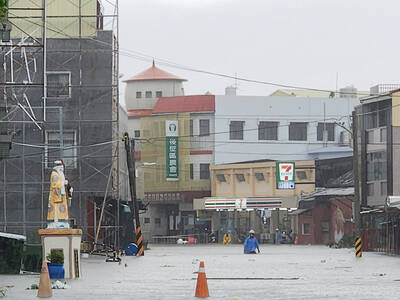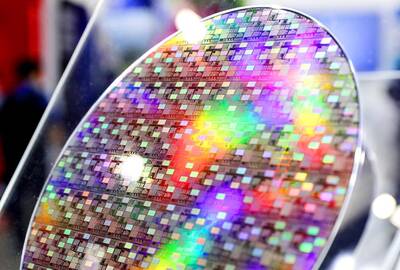The collapse of the US steel industry forced Drew Mihalek in 1977 to leave Pittsburgh, a onetime capital of industry that US President Barack Obama will show to world leaders this week as a “bold example” of a new green economy.
Mihalek, 58, recalls bubbling caldrons of metal during summer jobs at US Steel as a college student. Now he works in a dust-free workplace as an environmental health and safety manager at Solar Power Industries, a maker of solar cells.
Mihalek calls the change in his hometown “kind of like my own personal revitalization.” That shift will be in the spotlight this week as leaders from the G20 nations meet in various “green” buildings — a visible image of the new economy touted by the Obama administration.

PHOTO: REUTERS
Debate before the Pittsburgh summit of leading developed and developing countries has focused on bankers’ pay, regulation of the financial sector and how governments should withdraw from the enormous stimulus packages enacted to blunt the global economic crisis and spur growth.
Climate change and tackling high unemployment are other issues on the G20 agenda, tying into Obama’s vision for a green economy and why Pittsburgh is hosting the summit. But hopes for millions of new green jobs in the US economy may prove more ambitious than many advocates and investors dream of.
Central to a green economy are education, innovation and research, which Pittsburgh offers through schools like Carnegie Mellon University and the University of Pittsburgh. Also key are an educated work force and plentiful raw materials.
Andy Hannah, chief executive of Plextronics, a company that makes organic solar cells and organic light-emitting diodes and uses photoactive inks to print solar cells, said Pittsburgh offers the right mix of corporate and university talent.
Hannah also said Pittsburgh was a prime location for setting up Plextronics because raw materials such as aluminum, glass and plastics are produced locally.
Patrick McCarthy of ATRP Solutions, a polymer maker using technology developed at Carnegie Mellon, also said the key elements for a green company come together in Pittsburgh.
“In this city, we have a history of materials companies commercializing products. This expertise is not everywhere in the country,” McCarthy said.
Despite all its strides — Pittsburgh has one of the largest green collar work forces for a US city its size — some doubt green jobs will be a major engine for the economy.
Lester Lave, an economics professor and director of the Green Design Institute at Carnegie Mellon, said neither oil nor coal will be replaced any time soon. He also said politicians were overly optimistic in their assumptions about new jobs.
There has long been debate along left-right political lines about the viability of green energy and the large government funding needed to get renewable energy off the ground.
The US$787 billion economic stimulus package that Obama signed into law in February included more than US$60 billion in clean energy investments.
A green economy would boost energy independence and reduce a chronic US trade deficit, advocates say. But that dream is still far away: solar and wind power accounted for just 0.6 percent of US energy consumption last year, according to the US Energy Information Administration.
Another selling point for a green economy is that a green collar work force earns 10 percent to 20 percent more than other jobs, the Council of Economic Advisors has said. And those jobs are more likely to be union jobs, the council said.
The poster child for a green economy is solar power, which is expected to drive jobs growth, especially in installation.
But costs still outweigh benefits and industry experts say grid parity is a tipping point that is several years away. Grid parity refers to when solar costs come in line with the cost of electricity from the power grid.
Investors have made big bets on solar energy. There are about 45 publicly traded companies in the sector whose market capitalization is about US$50 billion.
A number of catalysts could spark a sudden conversion to solar panels, as was seen with the rapid adoption of cell phones in the late 1990s, said Shawn Kravetz, president of Esplanade Capital LLC in Boston, who has a fund dedicated to solar energy.
A tipping point could come earlier than many think, perhaps by 2011, especially if carbon taxes or a cap-and-trade program aimed at limiting carbon emissions comes about, Kravetz said. A fall in panel prices, cheap financing and the first solar panel to go up in a neighborhood are enough to spark sales, he said.
“People are more aware that solar isn’t a newfangled technology, it’s by-and-large a 30-year-old technology that works,” he said. “We just need to get the cost to where it’s cost effective, and where, thanks to some government support, we’re finally there.”

Rainfall is expected to become more widespread and persistent across central and southern Taiwan over the next few days, with the effects of the weather patterns becoming most prominent between last night and tomorrow, the Central Weather Administration (CWA) said yesterday. Independent meteorologist Daniel Wu (吳德榮) said that based on the latest forecast models of the combination of a low-pressure system and southwesterly winds, rainfall and flooding are expected to continue in central and southern Taiwan from today to Sunday. The CWA also warned of flash floods, thunder and lightning, and strong gusts in these areas, as well as landslides and fallen

WAITING GAME: The US has so far only offered a ‘best rate tariff,’ which officials assume is about 15 percent, the same as Japan, a person familiar with the matter said Taiwan and the US have completed “technical consultations” regarding tariffs and a finalized rate is expected to be released soon, Executive Yuan spokeswoman Michelle Lee (李慧芝) told a news conference yesterday, as a 90-day pause on US President Donald Trump’s “reciprocal” tariffs is set to expire today. The two countries have reached a “certain degree of consensus” on issues such as tariffs, nontariff trade barriers, trade facilitation, supply chain resilience and economic security, Lee said. They also discussed opportunities for cooperation, investment and procurement, she said. A joint statement is still being negotiated and would be released once the US government has made

SOUTH CHINA SEA? The Philippine president spoke of adding more classrooms and power plants, while skipping tensions with China over disputed areas Philippine President Ferdinand Marcos Jr yesterday blasted “useless and crumbling” flood control projects in a state of the nation address that focused on domestic issues after a months-long feud with his vice president. Addressing a joint session of congress after days of rain that left at least 31 dead, Marcos repeated his recent warning that the nation faced a climate change-driven “new normal,” while pledging to investigate publicly funded projects that had failed. “Let’s not pretend, the people know that these projects can breed corruption. Kickbacks ... for the boys,” he said, citing houses that were “swept away” by the floods. “Someone has

‘CRUDE’: The potential countermeasure is in response to South Africa renaming Taiwan’s representative offices and the insistence that it move out of Pretoria Taiwan is considering banning exports of semiconductors to South Africa after the latter unilaterally downgraded and changed the names of Taiwan’s two representative offices, the Ministry of Foreign Affairs (MOFA) said yesterday. On Monday last week, the South African Department of International Relations and Cooperation unilaterally released a statement saying that, as of April 1, the Taipei Liaison Offices in Pretoria and Cape Town had been renamed the “Taipei Commercial Office in Johannesburg” and the “Taipei Commercial Office in Cape Town.” Citing UN General Assembly Resolution 2758, it said that South Africa “recognizes the People’s Republic of China (PRC) as the sole